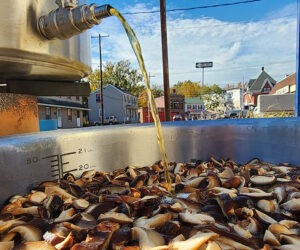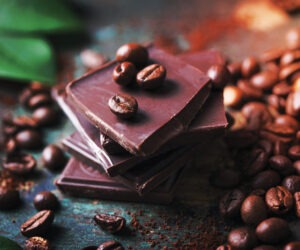Using Brewing Sugars: Tips from the Pros
Brewer: Jim Olen, Milwaukee Ale House in Milwaukee, WI
I have mainly used two brewing sugars over the past six years at the Milwaukee Ale House. The first is honey, which is used in the Downtown Lites Honey Ale (our most popular beer) and the second is Belgian candi sugar — used mainly for our seasonal Belgian style beers.
My use of honey as a brewing sugar is twofold: The main reason is to give the beer a certain lightness and drinkability. Secondly, it has a “pure and natural” appeal to our customers — we use 60 pounds of real Wisconsin honey in each 15-barrel batch.
Honey is about 95% fermentable, whereas the sugars derived from the mash are only 65–75% fermentable (this percentage depends on the temperature and thickness of the mash). Honey has the effect of producing wort that will result in a lower final gravity (than if all the sugars in the wort were from an all malt mash.)
I have found it best to add the honey at the end of boil. It is important to be sure to dilute the honey with very hot water (I dilute by 50%) before adding to the brew kettle, or the honey may stick to the bottom of the kettle and scorch. Adjust your recipe with this extra amount of water in mind.
Adding honey at the end of the boil kills any wild yeast or bacteria in the honey and neutralizes the natural diastatic enzymes, so as not to degrade the dextrins (non-fermentable malt-derived sugars) produced in the mash. Because the honey was not boiled, some honey flavor and aroma nuances can come through, though this may be difficult to detect. If you actually want to smell or taste honey, simply increase the amount you use in the recipe. Personally, I use honey to lighten the body, not necessarily for flavor or aroma.
For homebrewing I offer the following tips: Most homebrewers will want to have honey complement the flavors of the beer, not compete or overpower it. As a percent weight of the total grain bill, I recommend using 3–10% honey, which contributes a subtle honey flavor to the ale or lager. 11–30% provides a distinctly noticeable honey note. Keep this in consideration when thinking about what hops and specialty grains you’ll use. Over 30% and the flavor of honey will likely dominate the other flavors in your beer and push it closer to the mead category. I use almost 7.5% honey by weight as a percentage of the grist bill for the Downtown Lights. The grist bill itself is comprised of two-row base brewers malt, some pale ale base malt for additional color and malt aroma and Carapils or dextrin malt, to add some body to the finished beer. For extract brewers, it is recommended that 6–9% of honey is used in with liquid malt extract, and up to 10% more for a more defined honey flavor.
Belgian candi sugar is crystallized beet sugar and usually comes in light, amber and dark — with the differences (from my palate) being solely in color and not flavor. It’s widely used in strong Belgian (or Belgian-style) beers and is used to achieve alcoholic strength without letting the beer become too sweet. Belgian candi sugar is similar to honey in that it is highly fermentable, with most of the carbohydrates being converted into alcohol (and CO2) by the yeast during fermentation. Candi sugar, unlike honey, does not contribute much flavor (other than alcohol flavor) itself used in higher amounts.
In producing a Belgian style hombrew, the beer does not necessarily have to be high in alcohol. You can use the sugar like honey to lower your final gravity and produce a flavorful beer that is lighter in body. Try some imported Belgian beers and let their flavor and body be a guide. Note the strength, and to be truly authentic, buy true Belgian yeast strains from your favorite local homebrew shop. Also, try cultivating some yeast from the bottom of a bottle of a Belgian import.
For homebrew calculations in using Belgian candi sugar: One pound of candi sugar will yield a gravity of 11.25 °Plato, or a specific gravity of 1.045, in one gallon of water. Adjust the grain and extract requirements of your recipe accordingly if you add candi sugar. You can add the candi sugar at any point in the boil, keeping in mind that the sugar crystals are quite large and may require some stirring with a large spoon. At the Milwaukee Ale House, I used 66 pounds of light Belgian candi sugar in a Belgian style double that weighed in at almost 7% alcohol by volume.
Brewer: John Gillooly, Dogfish Head Craft Brewery in Lewes, DE
The main reason for the use of kettle sugars is to lighten the flavor and body of higher gravity beers. This happens because the sugars are almost entirely fermentable — thus leaving behind little to no residual sweetness or body in their wake, only alcohol. The sugars also contribute distinct aromas to the beer.
In Belgium, candi sugar is the most traditional of the kettle sugars. It is a very pure sugar, made from recrystalized, concentrated sugar syrup. It comes in pale, medium and dark grades. The color comes from the degree of caramelization of the sugar syrup. Dark candi sugar is often used to darken beers, more so than specialty malts.
At Dogfish Head, we use candi sugar in two of our beers: Raison D’Etre, which uses dark candi sugar, and Au Courant, which uses pale candi sugar. In the Raison, we feel that the candi sugar contributes to a complex, toasty and caramelly aroma, while lightening the body of this 19.5 ºPlato beer to the point that it is stealthy in its alcoholic punch.
In the Au Courant, the candi sugar plays a somewhat different role. As it was conceived as a 7% beer, we felt that getting all that extract from malt alone — even Pilsner malt — would leave too much malt and sweetness in the way.
If you want to get a good handle on how Belgian candi sugar impacts a beer, I recommend a simple experiment:
Make 5 gallons (19 L) of pale, 18 ºPlato wort using about 12–13 lbs. (5.4–5.9 kg) Pils malt if all-grain or 10-11 lbs. (4.5–5.0 kg) pale malt extract. Only use bittering hops, at about 25 IBU. Split the wort in half at the end of the boil, adding 1 lb. (0.45 kg) pale candi to one half, and 1 lb. (0.45 kg) dark candi to the other half. Ferment with the ale yeast of your choice — something fruity and alcohol tolerant. Both White Labs and Wyeast have multiple strains that would be acceptable.
After fermentation, you will have two wonderful beers — a Belgian brown ale and a Tripel. You will also have learned a lot about the impact of candi sugar on a beer.



